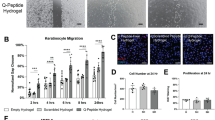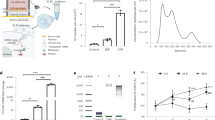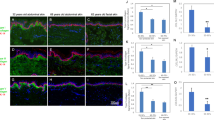Abstract
Keratinocyte growth factor (KGF) stimulates epithelial cell differentiation and proliferation, which are of major importance for wound healing. Local protein administration, however, has been shown to be ineffective due to enzymes and proteases in the wound fluid. We hypothesized that delivering KGF as a non-viral liposomal cDNA gene complex is a new approach that would effectively enhance dermal and epidermal regeneration. Twenty-two rats were given an acute wound and divided into two groups to receive weekly subcutaneous injections of liposomes plus the LacZ gene (0.2 μg, vehicle), or liposomes plus the KGF cDNA (2.2 μg) and LacZ cDNA (0.2 μg). Transfection was confirmed by histochemical assays for β-galactosidase. Planimetry, histological and immunohistochemical techniques were used to determine protein expression, dermal and epidermal regeneration. Transfection and subsequent KGF expression was found in diving cells in the granulation tissue. Epidermal regeneration was improved by 170% in rats receiving the KGF cDNA constructs by exhibiting the most rapid area and linear wound re-epithelialization, P < 0.0001. KGF improved epidermal cell net balance by increasing skin cell proliferation and decreasing skin cell apoptosis, P < 0.0001. Dermal regeneration was further improved in KGF cDNA treated animals by an increased collagen deposition and morphology, P < 0.0001. KGF cDNA increased neo-vascularization and concomitant VEGF concentrations when compared with vehicle, P < 0.01. KGF cDNA did not only stimulate epithelial cells, but also mesenchymal cells through increases in IGF-I concentration, P < 0.005. Liposomes containing the KGF cDNA gene constructs were effective in improving epidermal and dermal regeneration. KGF gene transfer to acute wounds may represent a new therapeutic strategy to enhance wound healing.
This is a preview of subscription content, access via your institution
Access options
Subscribe to this journal
Receive 12 print issues and online access
$259.00 per year
only $21.58 per issue
Buy this article
- Purchase on Springer Link
- Instant access to full article PDF
Prices may be subject to local taxes which are calculated during checkout







Similar content being viewed by others
References
Singer AJ, Clark RAF . Cutaneous wound healing N Engl J Med 1999 341: 738–746
Scharffetter-Kochanek K, Meewes C, Eming S, Brenneisen P . Chronic wounds and growth factors HG 1999 11: 664–672
Werner S et al. The function of KGF in morphogenesis and reepithelialization of wounds Science 1994 266: 819–823
Werner S . Keratinocyte growth factor: a unique player in epithelial repair processes Cytok Growth Factor Rev 1998 9: 153–165
Rubin JS et al. Keratinocyte growth factor Cell Biol Int 1995 19: 399–411
Smola H, Thiekötter G, Fusenig NE . Mutual induction of growth factor gene expression by epidermal-dermal cell interaction J Cell Biol 1993 122: 417–429
Winkles JA et al. Differential expression of the keratinocyte growth factor (KGF) and KGF receptor genes in human vascular smooth muscle cells and arteries J Cell Physiol 1997 173: 380–386
Finch PW et al. Human KGF is FGF-related with properties of paracrine effector of epithelial cells Science 1989 145: 752–755
Marchese C et al. Modulation of keratinocyte growth factor receptor expression in human cultured keratinocytes Cell Growth Diff 1997 265: 989–997
Werner S et al. Large induction of keratonicyte growth factor expression in the dermis during wound healing Proc Natl Acad Sci USA 1996 89: 6898–6900
Senaldi G et al. Keratinocyte growth factor protects murine hepatocytes from tumor necrosis-induced apoptosis in vivo and in vitro Hepatology 1998 27: 1584–1591
Martin P . Wound healing-aiming for perfect skin regeneration Science 1997 276: 75–81
Vogel JC . Non-viral skin gene therapy Hum Gene Ther 2000 11: 2253–2259
Jeschke MG, Barrow RE, Hawkins HK, Herndon DN . IGF-I gene transfer in thermal trauma Gene Therapy 1999 6: 1015–1020
Jeschke MG, Barrow RE, Hawkins HK, Herndon DN . Biodistribution and feasibility of non-viral IGF-I gene transfers in thermally injured skin Lab Invest 2000 80: 151–158
Wlaschek M, Achterberg V, Meyer-Ingold W . Proteases inhibitors protect growth factor activity in chronic wounds Br J Dermatol 1997 137: 646–650
Sun L et al. Transfection with a-FGF cDNA improves wound healing J Invest Dermatol 1994 108: 313–318
Werner S, Weinberg W, Liao X . Targeted expression of a dominant-negative FGF receptor mutant in the epidermis of transgenic mice reveals a role of FGF in keratinocyte organization and differentiation EMBO J 1993 12: 2635–2643
Clark RAF . Cutaneous wound repair Goldsmith LA (eds); Physiology, Biochemistry and Molecular Biology of the Skin Oxford University Press 1991 pp 576–601
Bauchle M, Fässler R, Werner S . Suppression of keratinocyte growth factor expression by glucocorticoids in vitro and during wound healing J Invest Dermatol 1995 105: 579–584
Reed JC . Bcl-2 and the regulation of programmed cell death J Cell Biol 1994 124: 1–6
Beg AA, Baltimore D . An essential role for NF-(B in preventing TNF induced cell death Science 1996 274: 782–784
Staiano-Coico L, Krueger JG, Rubin JS . Human keratinocyte growth factor effects in a porcine model of epithelial wound healing J Exp Med 1993 178: 865–878
Tonnesen MG, Feng X, Clark RA . Angiogenesis in wound healing J Invest Dermatol Symp Proc 2000 5: 40–46
Ferrara N . Vascular endothelial growth factor and the regulation of angiogenesis Recent Prog Hormon Res 2000 55: 15–36
Lauer G, Sollberg S, Cole M . Expression and proteolysis of vascular endothelial growth factor is increased in chronic wounds J Invest Dermatol 2000 115: 12–18
Swift ME, Kleinmann HK, DiPietro LA . Impaired wound repair and delayed angiogenesis in aged mice Lab Invest 1999 79: 1479–1487
Herndon DN, Wilmore DW, Mason AD Jr, Pruitt BA Jr . Development and analysis of a small animal model stimulating the human postburn hypermetabolic response J Surg Res 1978 25: 394–403
Jeschke MG et al. Therapeutic success and efficacy of non-viral liposomal cDNA gene transfer to the skin is dose-dependent Gene Therapy 2001 8: 1777–1784
Jeschke MG et al. Therapeutic success and efficacy of non-viral liposomal cDNA gene transfer to the skin is dose-dependent Romeis Mikroskopische Technik 17. Auflage. P Böck (ed.). Urban u Schwarzenberg Verlag: Munich, 1989, p 235 and p 500.
Acknowledgements
This study was supported by the Deutsche Forschungsgemeinschaft (DFG Je 233/1-2). This manuscript is dedicated to my son Alexander, who was born 8 July 2001.
Author information
Authors and Affiliations
Rights and permissions
About this article
Cite this article
Jeschke, M., Richter, G., Höfstädter, F. et al. Non-viral liposomal keratinocyte growth factor (KGF) cDNA gene transfer improves dermal and epidermal regeneration through stimulation of epithelial and mesenchymal factors. Gene Ther 9, 1065–1074 (2002). https://doi.org/10.1038/sj.gt.3301732
Received:
Accepted:
Published:
Issue Date:
DOI: https://doi.org/10.1038/sj.gt.3301732
Keywords
This article is cited by
-
Polymer-Based Delivery of Peptide Drugs to Treat Diabetes: Normalizing Hyperglycemia and Preventing Diabetic Complications
BioChip Journal (2022)
-
Basic concepts, current evidence, and future potential for gene therapy in managing cutaneous wounds
Biotechnology Letters (2019)
-
Organic components from scallop shell increase expression of keratinocyte growth factor in human skin fibroblast
Fisheries Science (2011)
-
The combination of IGF-I and KGF cDNA improves dermal and epidermal regeneration by increased VEGF expression and neovascularization
Gene Therapy (2007)
-
The structure and composition of liposomes can affect skin regeneration, morphology and growth factor expression in acute wounds
Gene Therapy (2005)



